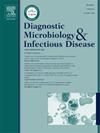基于靶向下一代测序的急性呼吸道感染住院患儿病原体流行病学研究
IF 1.8
4区 医学
Q3 INFECTIOUS DISEASES
Diagnostic microbiology and infectious disease
Pub Date : 2025-07-17
DOI:10.1016/j.diagmicrobio.2025.117017
引用次数: 0
摘要
背景:急性呼吸道感染(ARIs)仍然是儿童住院的主要原因,但其病因复杂性和年龄特异性流行病学模式尚不清楚。方法采用靶向新一代测序(tNGS)技术对1468例急性呼吸道感染住院患儿108种呼吸道病原体的患病率、季节性和年龄依赖性进行调查。结果病毒阳性率为64.7%,细菌阳性率为77.2%。排在前三位的病毒分别是人鼻病毒(18.5%)、人呼吸道合胞病毒B(7.7%)和人腺病毒B(7.0%),优势菌群分别是流感嗜血杆菌(35.6%)、肺炎支原体(27.9%)和肺炎链球菌(21.6%)。tNGS还鉴定出肠道病毒(4.1%)、parechovirus A(1.2%)、登革热病毒(1.0%)和百日咳博德泰拉(2.0%)等病原体。病毒和细菌检出率表现出不同的年龄依赖模式,从而实质上影响了合并感染动态。季节性趋势也显示出显著的差异,某些病原体在冬春季达到高峰,而其他病原体在全年持续流行。结论这些发现为理解急性呼吸道感染的发病机制提供了一个全面的框架,并强调了针对儿童人群的年龄诊断、季节性监测和抗菌药物管理的必要性,以优化临床管理。本文章由计算机程序翻译,如有差异,请以英文原文为准。
Pathogen epidemiological study of hospitalized children with acute respiratory infections based on targeted next-generation sequencing
Background
Acute respiratory infections (ARIs) remain a leading cause of pediatric hospitalization, yet their etiological complexity and age-specific epidemiological patterns are poorly characterized.
Methods
This study utilized targeted next-generation sequencing (tNGS) to investigate the prevalence, seasonality, and age-dependent dynamics of 108 respiratory pathogens in 1,468 hospitalized children with ARIs.
Results
Totally, 64.7 % were tested positive for viruses and 77.2 % were positive for bacteria. The top three viruses were human rhinovirus (18.5 %), human respiratory syncytial virus B (7.7 %) and human adenovirus B (7.0 %), and the predominant bacteria were Haemophilus influenzae (35.6 %), Mycoplasmoides pneumoniae (27.9 %) and Streptococcus pneumoniae (21.6 %). The tNGS additionally identified pathogens such as enterovirus (4.1 %), parechovirus A (1.2 %), dengue virus (1.0 %), and Bordetella pertussis (2.0 %). Viral and bacterial detection rates exhibited different age-dependent patterns, and thereby substantially influenced coinfection dynamics. Seasonal trends also revealed significant variability, with certain pathogens peaking during winter-spring months and others demonstrating sustained prevalence across the year.
Conclusion
These findings provided a comprehensive framework for understanding ARIs pathogenesis, and emphasized the need for age-tailored diagnostics, seasonal surveillance, and antimicrobial stewardship to optimize clinical management in pediatric populations.
求助全文
通过发布文献求助,成功后即可免费获取论文全文。
去求助
来源期刊
CiteScore
5.30
自引率
3.40%
发文量
149
审稿时长
56 days
期刊介绍:
Diagnostic Microbiology and Infectious Disease keeps you informed of the latest developments in clinical microbiology and the diagnosis and treatment of infectious diseases. Packed with rigorously peer-reviewed articles and studies in bacteriology, immunology, immunoserology, infectious diseases, mycology, parasitology, and virology, the journal examines new procedures, unusual cases, controversial issues, and important new literature. Diagnostic Microbiology and Infectious Disease distinguished independent editorial board, consisting of experts from many medical specialties, ensures you extensive and authoritative coverage.

 求助内容:
求助内容: 应助结果提醒方式:
应助结果提醒方式:


